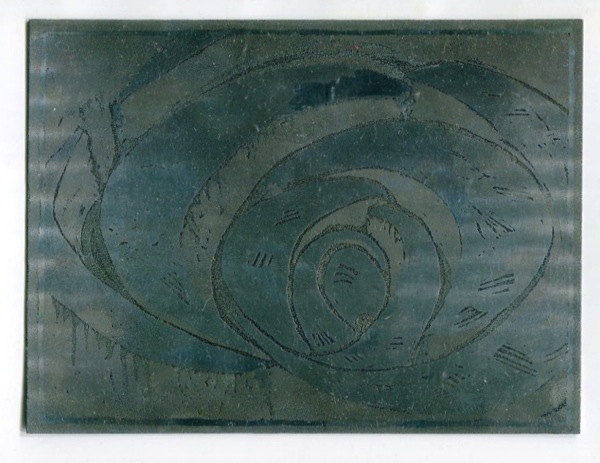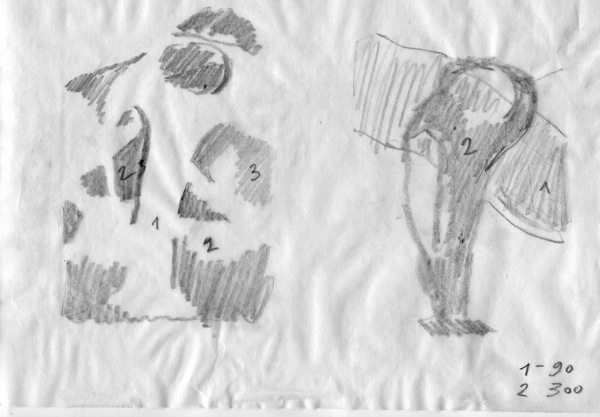My third experience of aquatint. My chosen focus in this workshop was on inking the plate in order to achieve better quality prints. Over two days, I created only two plates but focused on the process of printing rather than plate design and creation.
This workshop occurred immediately at the beginning of the school holidays and I had had no time to work on a design beforehand. As the focus was to be the printing process I elected to produce a simple abstract design. There was a wonderful book in the studio entitled “Sculpture Garden Kröller-Müller Museum” which I used for inspiration for both plates. The design of the first plate is based on a photograph of a sculpture entitled “Phyllotaxis” by Sjoerd Buisman (1987).
This time, I improved the planning process by marking out the different stages of lacquer application ahead of time using the numbering system shown in the sketch below. I was advised to use 3 stages for the first plate, which was then increased to 4 during the process. The lightest parts of the finished print are those marked “0” in the sketch. These were covered with Abdecklack before the plate went into the first acid bath (concentrated iron (III) chloride solution is used). The plate was then submerged in acid for 60 seconds. The parts marked “1” were then covered with Abdecklack followed, after drying thoroughly, 140 second submersion in the acid. This process continued with two further stages, one using a 220s and the other a 360s submersion. These timings were used in order to achieve more contrast.
The design used on the plate was made freehand as the process went along and is rather more abstract than the original drawing! I did not think to etch it first – forgot that I had done this last time – so there are no etched lines on the finished plate, only aquatinted shapes. The back of the plate is protected from acid damage by tape, which is removed prior to printing.

I took photos of the plate during the second and third stages:

This is a scan of the finished plate after I had made several prints. It needs a good clean before being used again but the residual ink helps in the reproduction of the scanned image. Not sure if lack of good cleaning immediately after printing damages the plate. Suspect it does if the ink dries within the crevices; at the very least, it must make it harder to clean.

The focus was to learn to ink a plate properly. The four images that follow are of the four prints that I have made so far from this plate. In the first one, even though the first print is always the weakest, I have removed far too much ink from the plate but include it here for comparison. The second one is better but I don’t like the white parts – too stark. I am pleased with the third print and with the colours used for the final one, which are quite well blended and give the image some depth. The trick is to work the ink well into the plate in the beginning, and then distribute it evenly on the plate and remove the excess using only gentle pressure. I removed the excess slowly and gently using the palm of one hand and clean pages of a telephone directory!




Barbara Hepworth’s 1958 sculpture Figure (Archaen) was the basis of the second plate. I decided to etch this plate prior to creating an aquatint. The initial sketch is shown below:

Unfortunately, probably due to a combination of too thinly applied lacquer on the plate and a damaged brush, the plate became scratched during its first immersion in the acid bath. Not having time to begin again and also out of curiosity to see what might be done with the “added texture”, I decided to continue. Here is the first print of the etching. I like the basic form of Hepworth’s figure, and of my interpretation of it, so was somewhat disheartened at this stage.

At this point I received assistance to help salvage the plate. Tracing paper was placed over the plate and a couple of ideas tried out. I decided to darken the figure, where the heaviest amount of scratching lay, which is the opposite of what was originally suggested.

The image below shows three stages in the making of the plate. I had decided that the main image would be dark, hence this part of the plate remains free of lacquer, in order that the acid can “bite” here to the fullest and, hopefully, reduce the impact of the scratches. The timings were 90s, 300s, 360s and an even longer exposure. Am embarrassed to say that I did not write the last two stages down and it is too long ago to remember accurately.…oh dear!

Here is the finished plate after a couple of prints had been made (scanned image). The need to make the central image dark, gives the odd impression of light coming in from the right hand side of the plate. Unusual but OK.

There was time to make two prints, using the slower process described for the first plate, above. The impact of the lines has been reduced but not eliminated. I would like to have another go using this imagery. However, it occurs to me that there may be copyright issues regarding using someone else’s imagery, even if reinterpreted in another medium. The first print was a bit “splodgy”, to use a technical term….

In the second print, I used up inks that were available on the “inking table” so it is a mixture of sanguine and a green shade. The ink is still not evenly distributed, which is in part due to my lack of skill and technique but, probably, is also partly due to the unevenness of the surface of the plate in the figure. I like the background design, which is an abstraction of the evergreens against which the sculpture was displayed in the photograph that I used, and also like the diagonal tonal band across the plate behind the figure (someone else’s idea).

Afterword: I had not previously heard of the Kröller-Müller Museum, which is situated in the beautiful De Hoge Veluwe National Park in the Netherlands, prior to the workshop but will try to visit both museum and the National Park in the not-too-distant future.








